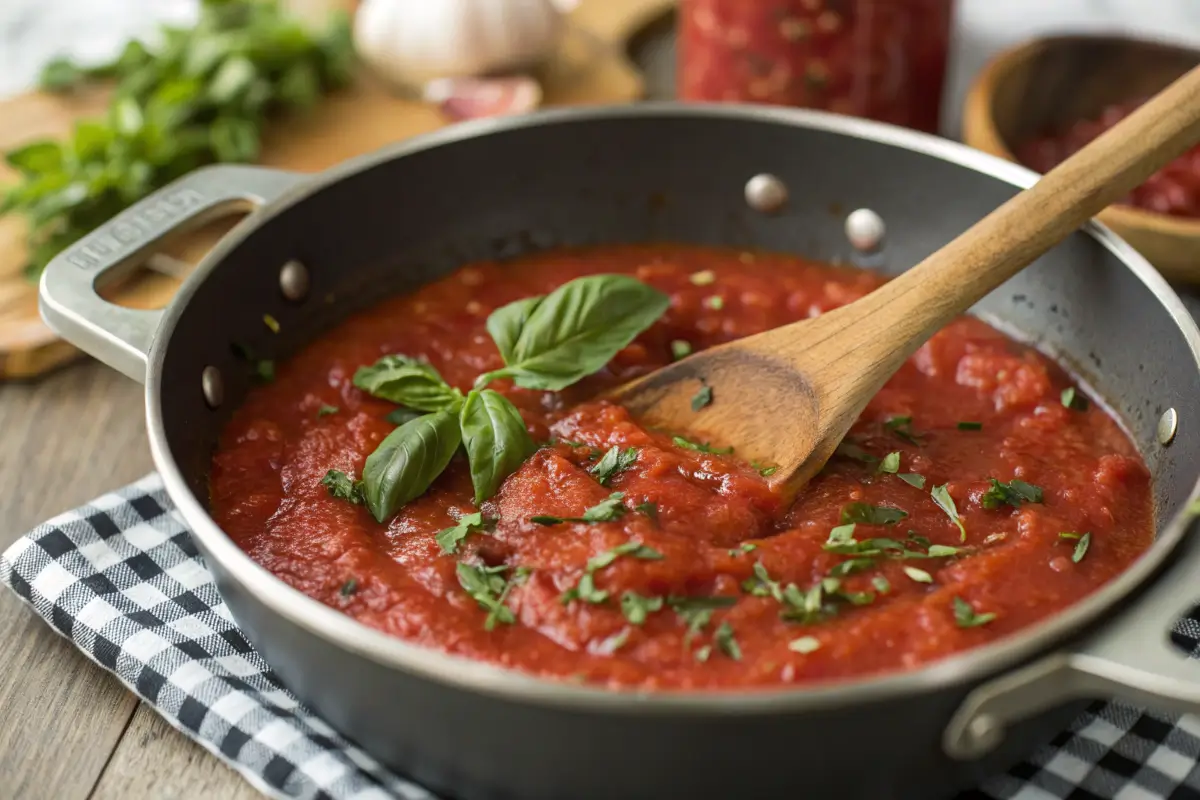Pizza lovers often debate what makes the perfect slice. Is it the crust, the toppings, or the sauce? One key detail that often stands out is whether the sauce is sweet. Some pizza sauces carry a hint of sugar, while others lean more savory, leaving people wondering: Why are some pizza sauces sweet? This article dives into the ingredients, science, and traditions behind sweet pizza sauces, exploring regional preferences, culinary trends, and tips for crafting your perfect sauce at home.
Introduction to Pizza Sauce Flavor Profiles
What Makes Pizza Sauce Unique?
Every pizza sauce tells its own story, a combination of ingredients, preparation methods, and personal flair. From the tangy punch of a classic Italian marinara to the subtle sweetness of an American-style sauce, the balance of flavors—sweetness, acidity, and umami—defines its personality. These sauces aren’t just there to complement the toppings; they’re foundational to the entire pizza experience.
Sweetness in pizza sauces is a deliberate choice. It can tame the natural acidity of tomatoes, harmonize with the saltiness of cheese, or stand out as a defining flavor. Whether you’re biting into a New York slice or a Detroit-style pie, that sweet undertone often lingers, sparking curiosity about what gives these sauces their signature taste.
The Importance of Flavor Balance
Sweetness is more than just a flavor; it’s a powerful tool in culinary arts. In pizza sauces, a touch of sweetness creates a delicate balance that satisfies the palate. Tomatoes, the primary ingredient in most sauces, naturally contain sugars, which intensify when cooked. Adding sugar or natural sweeteners enhances this effect, creating sauces that are rich, smooth, and irresistible.
Interestingly, sweetness isn’t just for the sake of taste. It also plays a practical role, balancing acidity and bitterness in tomatoes. Without this balance, pizza sauces could feel overly tangy or sharp. In some cases, cultural preferences and regional styles influence the level of sweetness, making it a hallmark of specific pizza traditions.
Ingredients That Enhance Sweetness in Sauces
Tomatoes: A Naturally Sweet Base
Tomatoes are the star of most pizza sauces, and their natural sweetness is often underestimated. Fresh, ripe tomatoes contain fructose and glucose, which are natural sugars. When these tomatoes are cooked, their sweetness becomes even more pronounced. This is due to the breakdown of complex carbohydrates during heating, releasing the natural sugars in a more concentrated form. San Marzano tomatoes, often used in traditional pizza sauces, are particularly renowned for their rich, sweet flavor.
Adding Sugar and Sweeteners for Depth
To amplify the sweetness of the sauce, many recipes include added sugars. Granulated sugar, honey, or even agave syrup are common choices. These sweeteners not only balance the sauce’s acidity but also enhance its overall flavor. Interestingly, many commercial pizza sauces rely on high-fructose corn syrup as a cost-effective sweetener. However, health-conscious home cooks often prefer alternatives like maple syrup or brown sugar for a more natural touch.
How Cooking Techniques Bring Out Sweet Flavors
Caramelization plays a pivotal role in the flavor of sweet pizza sauces. As onions, garlic, or tomatoes are sautéed, their natural sugars begin to caramelize, adding depth and a slight sweetness to the sauce. Cooking the sauce for longer at a low temperature allows these flavors to develop further, resulting in a richer, sweeter taste. This slow-simmering process is what makes homemade sauces particularly delightful.
For those interested in experimenting with sweet sauces, you might explore Mark’s Sweet Pizza Sauce recipe for a creative twist on the classic flavor.
Regional Styles and Preferences for Sweet Sauces
Sweet Sauces in American-Style Pizzas
In the United States, sweetness is often synonymous with comfort food. Many popular pizza chains, including Domino’s and Papa John’s, use sweet pizza sauces to appeal to American palates. This preference for sweetness can be traced back to the influence of Southern cuisine, where sugar is a staple ingredient in many dishes. As a result, sweeter sauces dominate in many parts of the U.S., especially in states like Michigan, where Detroit-style pizza features a thick, sweet tomato sauce.
Global Takes on Pizza Sauce Sweetness
While American pizza often emphasizes sweetness, Italian sauces tend to prioritize acidity and freshness. Traditional Italian marinara or Neapolitan sauces focus on the natural flavor of the tomatoes, with little to no added sugar. In contrast, Asian-inspired pizzas in countries like Japan or South Korea sometimes incorporate sweet sauces with a teriyaki or honey base, showcasing a cultural twist on the global pizza trend.
A Brief History of Evolving Pizza Sauce Flavors
Sweet pizza sauces weren’t always this prevalent. Historically, pizza was a savory dish, with minimal seasoning to highlight the simplicity of fresh ingredients. The shift toward sweeter sauces likely occurred as pizza became commercialized, catering to a broader range of tastes. Over time, sweetness became a defining feature in many regional styles, particularly in the Midwest and Northeast of the United States.
Science Behind Sweet Pizza Sauces
The Chemistry of Sweetness in Tomato-Based Sauces
The natural sugars in tomatoes play a significant role in creating the sweet flavors found in some pizza sauces. As tomatoes are cooked, the heat breaks down their cellular structure, releasing these sugars and intensifying their sweetness. This process, known as the Maillard reaction, occurs when sugars interact with amino acids during cooking, adding complexity and depth to the sauce’s flavor.
Moreover, some varieties of tomatoes, such as cherry or grape tomatoes, have a higher natural sugar content, which makes them ideal for creating sweeter sauces. Combining these tomatoes with slow cooking enhances their sweetness while reducing their acidity, striking a harmonious balance that appeals to the palate.
Why Sweetness Balances Acidity and Umami
Acidity is a key characteristic of tomatoes, but when it’s too strong, it can overpower other flavors. Sweetness counteracts this sharpness, creating a smooth and balanced sauce. Additionally, sweetness enhances the umami in tomatoes—a savory taste that adds richness and depth. This balance of sweet, acidic, and umami flavors is why sweet pizza sauces feel so satisfying.
Sweet Pizza Sauces in Modern Culinary Trends
Fusion Pizzas Featuring Sweet Sauces
In recent years, sweet pizza sauces have found their way into modern culinary trends, especially in fusion cuisine. For example, barbecue chicken pizzas often use a sweet barbecue sauce as the base, blending smoky and sugary flavors. Similarly, Hawaiian pizzas pair sweet tomato sauces with pineapple and ham, creating a unique mix of sweet and savory.
Even dessert pizzas have emerged as a trend, using sweetened sauces made from chocolate or fruit puree. These creative variations demonstrate how versatile sweet pizza sauces can be, breaking away from traditional expectations.
Popular Brands and Their Signature Sweet Sauces
Many popular pizza chains have developed signature sweet sauces to cater to a broader audience. Domino’s and Papa John’s, for instance, are known for their slightly sweet marinara sauces, designed to complement their cheese and crust recipes. These brands understand that sweetness appeals to a wide range of palates, especially in the U.S., where sugar is often a staple ingredient in comfort foods.
How to Make Your Own Sweet Pizza Sauce

Choosing Ingredients for a Sweet Sauce
Creating your own sweet pizza sauce is easier than you might think! The key is to start with high-quality, ripe tomatoes. Opt for sweeter varieties like Roma, San Marzano, or cherry tomatoes, as their natural sugar content provides the perfect base. Fresh garlic and onions also contribute a subtle sweetness, especially when sautéed to caramelize their natural sugars.
For additional sweetness, consider using natural sweeteners like honey, brown sugar, or maple syrup. These options not only enhance the flavor but also add a rich depth to your sauce. If you prefer a more tangy balance, include a splash of balsamic vinegar, which brings a touch of sweetness while complementing the sauce’s acidity.
Recipe: Classic Sweet Pizza Sauce
Here’s a simple recipe to get you started:
Ingredients:
- 2 cups of fresh or canned tomatoes (preferably San Marzano)
- 1 small onion, finely chopped
- 2 garlic cloves, minced
- 2 tbsp olive oil
- 1-2 tbsp brown sugar (adjust to taste)
- 1 tbsp tomato paste
- 1 tsp dried basil
- 1 tsp dried oregano
- Salt and pepper to taste
Instructions:
- Heat the olive oil in a saucepan over medium heat. Sauté the onions until soft and translucent.
- Add the garlic and cook for another minute.
- Stir in the tomatoes, tomato paste, and dried herbs. Let the mixture simmer for about 15 minutes, stirring occasionally.
- Add the brown sugar and continue simmering until the sauce thickens to your liking.
- Season with salt and pepper, and blend the sauce for a smooth texture if desired.
Tips for Adjusting Sweetness in Homemade Pizza Sauces
One of the best things about making your own sauce is the ability to tweak the flavors. If your sauce feels too tangy, add a little more sugar or a drizzle of honey to balance it out. On the other hand, if you find the sweetness too strong, a splash of lemon juice or a pinch of salt can help tone it down.
Don’t forget to taste as you go. The perfect sweet pizza sauce is all about finding that balance between sweetness, acidity, and savory notes.
Frequently Asked Questions (FAQs)
Why Do Some Pizza Sauces Taste Sweeter Than Others?
The sweetness in pizza sauces often comes from a combination of natural sugars in tomatoes and added sweeteners. Cooking methods, like caramelizing onions or slow-simmering tomatoes, can also enhance the sauce’s sweetness.
Is Sugar Always Added to Pizza Sauce?
Not always! While some recipes include added sugar, others rely solely on the natural sweetness of tomatoes. Slow cooking or using sweeter tomato varieties like cherry tomatoes can eliminate the need for added sugar.
What’s the Difference Between Sweet and Savory Pizza Sauces?
Sweet pizza sauces are typically enhanced with sugar or honey, offering a more pronounced sweetness that balances tangy and salty flavors. Savory sauces, however, focus on the natural acidity and umami of tomatoes, with minimal sweetness.
How Can I Reduce the Sweetness in Store-Bought Pizza Sauce?
If your store-bought sauce tastes too sweet, try mixing in unsweetened tomato paste, adding a splash of vinegar, or seasoning with extra salt and spices to tone down the sweetness.
Conclusion: Sweetness in Pizza Sauces – A Matter of Taste

Revisiting Why Sweetness Matters in Pizza Sauce
So, why are some pizza sauces sweet? The answer lies in a delicate interplay of natural ingredients, cooking techniques, and personal or regional preferences. Sweetness enhances the flavors of tomatoes, balances acidity, and creates a harmony that complements a wide range of toppings. It’s this balance that makes sweet pizza sauces so appealing, whether you’re enjoying a classic pepperoni slice or experimenting with a modern dessert pizza.
Beyond taste, sweetness can evoke a sense of nostalgia and comfort. For many, it’s a hallmark of American-style pizzas, where a hint of sugar in the sauce defines the experience. At the same time, the sweetness in pizza sauces isn’t universal—it’s a choice, rooted in tradition and the creativity of chefs and home cooks alike.
Encouraging Experimentation with Flavors
The beauty of pizza sauce lies in its versatility. Whether you prefer a naturally sweet flavor from slow-cooked tomatoes or like to experiment with honey or maple syrup, there’s no right or wrong way to make it. Try creating your own sweet pizza sauce at home, and don’t be afraid to adjust it to your taste. After all, the best pizza sauce is the one that keeps you coming back for more!

